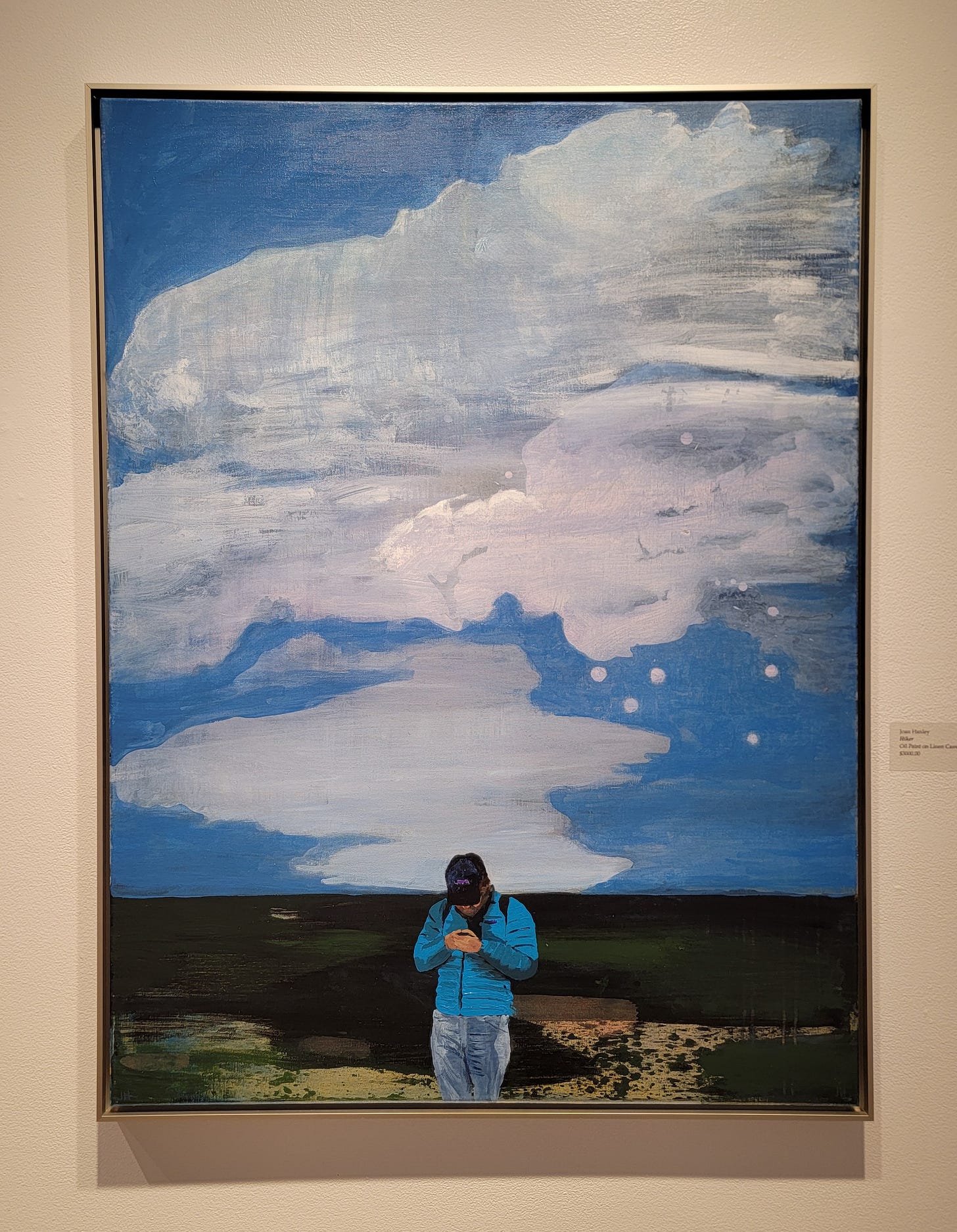Reclaiming Art in the Age of Artifice (1)
An Asynchronous Studio Book Club reading of Reclaiming Art in the Age of Artifice: A Treatise, Critique, and Call to Action by J.F. Martel.
I am presently wondering how the hell I got it in my head that Reclaiming Art in the Age of Artifice was a short book that I could get through in a week. My attempt to do so anyway was thwarted by an especially challenging few days, neurobiologically speaking. I have a forthcoming post about the associated condition, but for the time being, my impressions of reading this book so far have dissolved like so much sea foam in a brisk wind. I’m going to have to start over. I’m disappointed, but I’ve learned that you can’t shame your brain into attentiveness.
Joan Hanley had an opening last night up in Lebanon, NH, which stopped me from further abortive attempts at reading. This painting is in the exhibition. (Phone shot, I’ll be happy to replace it if she sends something better.) It’s titled Hiker, oil on linen, a few feet high.
On page 26 of Reclaiming Art, where my brain finally bailed out, it reads, “If the majority of aesthetic works fails to astonish us, then, it may have something to do with the ingrained insensitivity that is part and parcel of contemporary life.” Hiker rather encapsulates that ingrained insensitivity. Truly, it captures something even more dire: as if God was calling down to Abraham, with Abraham answering, “Yo, I’m busy.” I don’t judge the figure so much as I wonder if it’s me in some way.
Fortunately reader D.C. Alan sent in some more astute thoughts, and permitted me to quote him again:
Martel addresses the dichotomy suggested by the book’s title, to which the discussion has been leading and from which it will follow: “Artifice forgoes the revelatory power that is art’s prerogative in order to impart information, be it a message, an opinion, a judgment, a psychological stimulus, or a command…. Proper art moves us, while artifice tries to make us move.” (pp. 27-28) There is some dispute as to with whom the quip originated (Samuel Goldwyn? Moss Hart? Frank Capra?), but the remark deserves mention here: “If you want to send a message, try Western Union.”
Chapter Three, “Terrible Beauty,” opens with a valuable few paragraphs that must have taken some sharp intellectual skill to write, in which Martel concisely summarizes Immanuel Kant’s theories of aesthetic beauty—complex and challenging ideas with a deep history and wide subsequent influence, about which persons who strive for informed discourse in the arts should be aware, but which receive continually lesser attention as such philosophical literacy loses its importance (pp. 39-42).
He continues in the chapter to develop a survey of changing and diverging attitudes about and expressions of concepts of beauty and the beautiful, with his own critiques thereof. Sculptor Richard Serra having left this world earlier in the season, this might be an appropriate opportunity to recall his notorious and widely quoted declaration from the 1980s, “I don’t think it is the function of art to be pleasing.” (That prompted Newsweek columnist George Will to retort, “He thinks it is the function of the public to give people like him money and space and limitless license. In fine, the public is to pay up and shut up.”)
Feel free to add your own in the comments.
The ASBC calendar is about to get a rejigger. Since we can’t do Wilhelm Worringer in one week, it’s getting pushed until after the break with cascading effects on Thomas Bernhard and Marco Grassi. We may as well take our time with Reclaiming Art with the freed-up couple of weeks, which we will.
Thanks for your patience.
Content at DMJ is free but paid subscriptions keep it coming. Please consider one for yourself and thank you for reading.
The current entry of the Asynchronous Studio Book Club is Reclaiming Art in the Age of Artifice: A Treatise, Critique, and Call to Action by J.F. Martel. For more information see the ASBC calendar.
Dissident Muse’s first publication, Backseat Driver by James Croak, is available now at Amazon.
Aphorisms for Artists: 100 Ways Toward Better Art by Walter Darby Bannard is out now at Allworth Press. More information is available at the site for the book. If you own it already, thank you; please consider reviewing the book at Amazon, B&N, or Goodreads.





A corollary to that movie maxim (which Hollywood has obviously discarded) is that, in terms of art, the message (whatever it may be) is not the principal issue, but rather how well the artist handles it.
As for Serra, I'm afraid his views on art have no bearing on mine and do not concern me.
…” Proper art moves us while artifice tries to make us move.” Yes. Very good.